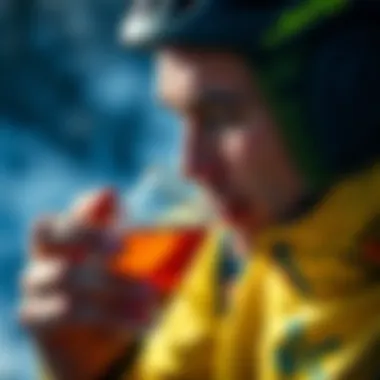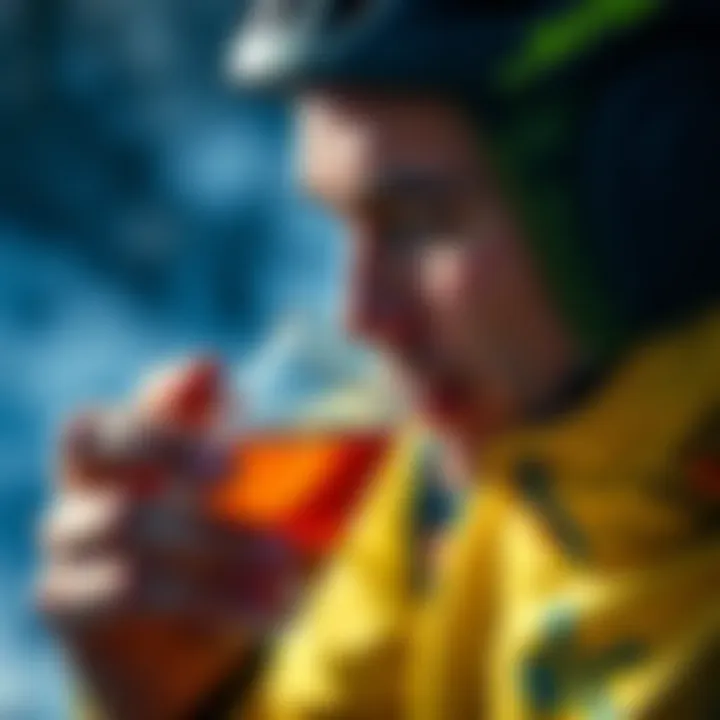Assessing Dehydration: Methods to Identify Hydration Levels


Intro
Staying on top of your hydration game is crucial, especially when you’re out there pushing your limits in extreme sports. A few hours of high-intensity activity can leave even the most seasoned athletes in a dehydrated state. The stakes get higher when you’re racing down mountains on a snowboard or scaling cliffs on a rock face. Understanding how to assess hydration and tackle dehydration effectively can mean the difference between a stellar performance and a potentially dangerous situation.
Before diving into practical methods and tools, it’s essential to grasp the significance of adequate hydration. This isn’t just about sipping water here and there; it’s about maintaining a delicate balance crucial to physical health and peak performance. From physiological signs to personal assessments, this article will guide you step by step through the processes you need to employ in order to ensure you are hydrated enough to face any challenge.
In the coming sections, you'll discover key techniques and tips for monitoring hydration, what gear might come in handy, and how to prioritize safety in extreme conditions, all while keeping an eye out for those telltale signs of dehydration.
Understanding Dehydration
Understanding the nuances of dehydration is vital, especially for those who engage in extreme sports. The demands on the body during these high-octane activities can lead to rapid fluctuations in hydration levels. When adrenaline is pumping and sweat is pouring, the importance of staying hydrated can easily be overlooked amidst the excitement. However, grasping the concept of dehydration not only enhances performance but also safeguards against potentially serious health risks.
Dehydration occurs when the body loses more fluids than it takes in. This imbalance can stem from various sources—be it intense physical activity, environmental factors, or even certain health conditions. Recognizing the signs of dehydration early can mean the difference between pushing through a tough session and risking severe consequences.
To truly appreciate the implications of dehydration, it’s essential to explore its definition and types, understand its underlying causes, and acknowledge its particular significance in extreme sports.
Definition and Types of Dehydration
Dehydration can be classified into several categories, each characterized by distinct features. Isotonic dehydration represents a situation where both water and salt are lost in equal proportions. This is common during intense workouts when fluids are lost through sweat but replaced with plain water, potentially resulting in an electrolyte imbalance.
On the other hand, hypertonic dehydration occurs when the body loses more water than salt. This can happen in hot climates or during prolonged exercise without adequate fluid intake. In contrast, hypotonic dehydration happens when there’s excessive loss of salt relative to water, frequently observed in conditions such as excessive vomiting or diarrhea. Each type of dehydration has its own set of implications and requires tailored responses for effective management.
“Understanding the types of dehydration enables individuals to make informed decisions on replenishment strategies.”
Causes of Dehydration
Diving deeper into the origins of dehydration can unveil a range of contributing factors. For instance, extreme couplings of heat and high energy exertion are classic scenarios that can lead to a quick onset of dehydration. Additionally, not drinking enough fluids before, during, and after physical activity can exacerbate the condition.
Moreover, other factors such as illness, diarrhea, or high-altitude conditions can also precipitate dehydration. Even simple lifestyle choices—like consuming diuretics such as caffeinated beverages or alcohol—can play a role. Awareness of these causes is crucial for anyone aiming to maintain optimal hydration levels while participating in physically demanding activities.
Significance of Hydration in Extreme Sports
Athletes involved in extreme sports face unique challenges regarding hydration. The intensity and duration of these activities can lead to significant fluid loss, which may hinder performance. Dehydration can reduce endurance, diminish coordination, and impair judgment—situations no one wants to encounter while navigating treacherous terrain at high speeds.
Moreover, staying hydrated is not just about performance; it's about safety. Fatigue, cramps, and, in severe cases, heat exhaustion or heat stroke can occur in dehydrated individuals. An emphasis on hydration strategies that include regular water intake and electrolyte replenishment should be a foundational element of any extreme sports training regimen.
In sum, understanding hydration's role in extreme sports is paramount. It’s about creating a sustained approach that integrates knowledge of dehydration's types, causes, and effects to not only enhance performance but to also ensure long-term health and safety in high-stakes environments.
Common Symptoms of Dehydration
Recognizing the common symptoms of dehydration is vital for anyone engaged in strenuous activities, such as extreme sports. Being aware of these signs allows athletes to react promptly, preventing the situation from worsening, which can lead to serious health complications. It’s not all about quenching thirst; understanding how your body communicates its need for fluids is critical.
Physical Indicators
Physical symptoms often serve as the earliest warning signs that hydration levels are dropping. Some of these indicators are fairly obvious, while others may be more subtle. Here are a few of the most common physical symptoms:
- Dry mouth and throat: A dry mouth isn’t just annoying; it’s a clear sign that your body is craving more fluids.
- Decreased urine output: When you’re hydrated, your urine should have a light yellow hue. If it turns dark and is scanty, it’s a wake-up call to replenish.
- Fatigue and weakness: Feeling unusually fatigued or weak may be linked to inadequate fluid intake, hindering your performance and endurance.
- Dizziness or lightheadedness: Changes in blood volume due to dehydration can lead to low blood pressure, causing these sensations.
- Rapid heart rate: A faster heartbeat can signal that your body is struggling to maintain normal functions due to a shortage of fluids.
Recognizing these physical indications can provide a sense of urgency. Feeling off-balance or lightheaded during a run might just mean you need a drink. Addressing it sooner can make all the difference between finishing strong and hitting the wall.
Cognitive and Emotional Effects
Dehydration doesn’t only affect the body; it also takes a toll on the mind and emotions. As hydration levels drop, cognitive functions often decline. Some psychological symptoms to watch for include:
- Confusion and irritability: Feeling more easily frustrated or disoriented may be a byproduct of mild dehydration.
- Lack of focus or concentration: Difficulty focusing, even on tasks you usually enjoy, can signal that you’re not hydrated properly.
- Increased anxiety: In some cases, the stress of trying to perform under physical strain can exacerbate feelings of anxiety when dehydration sets in.
Understanding the connection between hydration and mental performance is crucial for thrill-seekers. When your mind isn’t sharp, your reaction times may slow down, leading to potential dangers in high-stakes environments.


Severity Classification of Symptoms
Not all symptoms of dehydration are created equal. It’s critical to classify the severity of these symptoms to gauge the appropriate response. Understanding this hierarchy can shape how quickly you address your hydration needs:
- Mild Dehydration: Symptoms such as slight dizziness, dry mouth, and slight decrease in urine output. Often manageable with increased fluid intake.
- Moderate Dehydration: Includes fatigue, headaches, and more pronounced dizziness. At this stage, it is essential to take a break, hydrate, and monitor recovery closely.
- Severe Dehydration: Characterized by confusion, rapid pulse, and extreme weakness. This is a medical emergency, requiring immediate intervention.
Recognizing the signs early can help prevent dehydration from escalating to dangerous levels.
Keeping an eye on these categories can help athletes distinguish between minor discomfort and more serious conditions. Making timely choices based on symptom severity ensures that you maintain peak performance while mitigating risks.
By being attuned to your body’s signs and acting accordingly, you can improve your endurance, focus, and overall safety in extreme sports. Failure to heed these warnings may not only undermine your performance but could also lead to health risks that are far from trivial.
Self-Assessment Techniques
Understanding hydration levels is crucial, especially for those who push their limits in extreme sports. Self-assessment techniques serve as valuable tools that empower athletes and thrill-seekers to identify their hydration state without the need for professional equipment. These simple, yet effective methods can aid in making swift decisions about fluid intake, ensuring that performance remains at its peak while minimizing the risks associated with dehydration.
Benefits of Self-Assessment Techniques
Self-assessment techniques not only promote awareness but also encourage proactive hydration management. Knowing how to evaluate one’s hydration level can lead to better decisions in high-adrenaline situations, where every second counts. Incorporating these techniques can result in enhanced physical performance, improved focus, and ultimately a more enjoyable experience during extreme activities.
Hydration Tracking through Urine Color
One of the easiest and most accessible methods for self-assessing hydration is monitoring urine color. The color can signal whether your body has enough fluid or if it’s urging for more. Generally, if urine is light yellow or pale straw, this indicates proper hydration. Darker shades, such as amber or honey, may suggest dehydration, signaling the need for immediate rehydration.
- Color Chart for Reference:
- Light yellow: well-hydrated
- Dark yellow: mild dehydration
- Amber/dark brown: severe dehydration
The beauty of this method lies in its simplicity; anyone can utilize it during or after physical activity. Just remember to check your urine after using the restroom to get the clearest picture of your hydration status.
Monitoring Thirst Levels
Thirst is a primary indicator of hydration levels. It’s our body's own signal that says, "Hey, I need some water!" However, it’s important to realize that by the time you feel thirsty, you may already be on the dehydated side of things. Keeping track of your thirst levels before, during, and after exercise can give you valuable insights into your body's needs. For extreme athletes or those deep in adventures, setting regular intervals to assess both thirst and fluid intake can streamline hydration strategies.
- Key Points for Monitoring Thirst:
- Before Activity: Drink adequately, so you start off well-hydrated.
- During Activity: Pay attention to how thirsty you feel; sip water regularly.
- After Activity: Rehydrate according to the thirst level observed.
By building a habit of listening to what your body says, you create a more responsive hydration approach, reducing the risk of severe dehydration.
Body Weight Changes before and after Activity
Another method to assess hydration is by measuring body weight changes before and after exercise. This technique provides a more quantitative approach, providing insights beyond subjective feelings. The general rule is a loss of 1% or more of body weight can indicate dehydration. Thus weighing yourself before and after activity allows you to calculate fluid needs accurately.
For example, if you weigh 150 pounds before a long run and 148 pounds after, that's a 2-pound loss—a clear indicator that fluid intake was insufficient during exercise.
- Calculating Fluid Needs:
- For every pound lost, it's advisable to replace with about 16 ounces of fluids.
- Create an action plan based on typical losses to better prepare for future activities.
Combining these self-assessment techniques can create a robust understanding of hydration levels. Regular practice of these methods, especially for those engaged in demanding sports, can lead to wiser decisions that increase safety and enhance performance during extreme activities.
Professional Assessment Methods
When it comes to knowing how hydrated—or dehydrated—you are, personal assessments can only go so far. That’s where professional assessment methods come into play. These techniques are crucial for athletes and extreme sports enthusiasts who operate at the very edge of physical performance. Ignoring adequate evaluation methods can lead one down a stormy path of health risks, including decreased performance and even life-threatening conditions. Relying on experts for hydration evaluation can provide insights that one simply can't get from rough heuristics.
Utilizing scientific and precise measurement tools, professional assessment methods help gauge hydration status more accurately than one’s untrained perceptions. For anyone who enjoys pushing their limits, understanding these methods can inform better hydration strategies, maintaining both safety and performance during high-intensity activities.
Blood Tests and Hydration Status
Blood tests are perhaps the gold standard when it comes to measuring hydration levels. They can highlight various biomarkers that indicate not just hydration status but also the overall health of an athlete.


For instance, tests that measure electrolyte levels—such as sodium and potassium—can give a comprehensive picture of how well your body is managing hydration. Dehydration can throw these levels out of whack, leading to serious health issues if not addressed. Thus, a simple blood test may uncover problems that the naked eye can't see.
“A blood test can reveal not just whether you're hydrated, but also how well your body is functioning overall.”
These tests are particularly necessary for high-performance athletes who require finely-tuned hydration management. If someone is sweating buckets in a three-hour endurance race, they may not realize how dramatically their blood makeup changes due to fluid loss. Prompt testing can guide timely intervention, allowing for swift action to restore balance.
Bioelectrical Impedance Analysis
Next up is bioelectrical impedance analysis (BIA), which is increasingly gaining traction in sports and fitness communities. This method evaluates the resistance of body tissues to a small electrical current, offering readings that can indicate hydration levels among other things.
Unlike blood tests, BIA is non-invasive and can be done quickly, making it a practical choice for regular assessments. Athletes can use BIA to track hydration over time, which can be invaluable for conditioning routines. It helps to predict hydration status based on body composition, ensuring that one is preparing and recovering properly.
The beauty of BIA lies in its ability to provide athletes with actionable data without requiring them to draw blood. This means you can jump on the machine and in minutes, receive tailored insights into your hydration needs. However, it's essential to consider factors like food and fluid intake before the test, as these can significantly influence the results.
Skin Turgor Test
Finally, let’s talk about the skin turgor test, which is perhaps the most straightforward of the professional assessment methods. This test involves pinching the skin and observing how quickly it returns to its normal state.
In a well-hydrated individual, the skin snaps back quickly. If it stays tented or takes longer to return to its normal state, it may indicate dehydration. Although the skin turgor test is often employed in clinical settings, it can also be a simple method for athletes to assess hydration, especially when professional testing isn’t immediately available.
However, it’s worth noting that this method is more effective in severe cases of dehydration and may not be sensitive enough for subtle changes. Yet, when combined with other professional methods, it can serve as a quick screening tool.
In summary, professional assessment methods offer reliable insights into hydration status for athletes, helping to bridge the gap between subjective feelings and objective measurements. These methods not only enhance performance but can also be pivotal in preventing serious health issues during extreme sports.
Implications of Dehydration for Athletes
Dehydration can be a silent adversary, creeping into the lives of athletes when they least expect it. Understanding the implications of dehydration is vital, particularly for those pushing their physical boundaries in extreme sports. This section delves into how dehydration can impact performance, recovery, and injury risks, aspects that every athlete needs to consider.
Impact on Physical Performance
When dehydration sets in, the effect on an athlete's performance can be profound. Even a slight drop in hydration levels—around 2% of body weight—can impair physical capabilities. Imagine you're out on a trail, pushing your stamina to its limits. Your muscles, starved of crucial fluids, can begin to cramp and fatigue more quickly. This doesn’t just throw a wrench in your day; it can compromise a whole season. Whether it’s climbing, cycling, or running, every sport demands optimal hydration to maintain endurance and strength.
In addition to affecting muscle function, dehydration can lead to overheating during intense activities. This is particularly true in extreme sports where conditions can be harsh, such as climbing in high temperatures or trail running on sun-blasted paths. A dehydrated body struggles to regulate temperature, increasing the risk of heat-related illnesses. As a result, athletes may find themselves battling not just fatigue but also the serious threat of heat exhaustion or heat stroke.
Effects on Recovery and Injury Risks
Recovery is another crucial aspect where hydration plays an integral role. After a blistering workout or competition, the body needs the right conditions to repair itself. Water aids in metabolic processes, nutrient transport, and toxin removal—all pivotal for effective recovery. Without adequate hydration, recovery can be delayed, leading to muscle soreness that lasts longer than it should. A well-hydrated athlete tends to bounce back faster and return to training sooner than one who is not.
Additionally, dehydration can elevate the risk of injuries. An insufficient intake of fluids may impact coordination and concentration, which are essential for avoiding mishaps during high-adrenaline activities. This is especially pertinent in situations where split-second decisions can make the difference between success and a nasty fall. Athletes who overlook their hydration status place themselves at greater risk of strains, sprains, and other injuries that could sideline them.
Remember: Regular hydration isn’t just about drinking water; it’s about understanding your body’s needs and scheduling your intake based on activity level and environment.
To wrap it up, dehydration doesn't just hinder performance; it creates a cascade of effects that can derail recovery and increase injury risks. Athletes, particularly those engaging in extreme sports, must recognize hydration as a crucial element of their training and competition strategy.
For more insights into hydration's impact on performance, resources such as Wikipedia and Britannica provide valuable information.
Hydration Strategies for Extreme Sports
Hydration plays a pivotal role in the performance and safety of athletes involved in extreme sports. When adrenaline is pumping and competition is fierce, the body faces heightened risks of dehydration. This section will explore practical hydration strategies that athletes can implement to maintain optimal performance levels and safeguard their health during intense activities.
Fluid Replacement Guidelines
Fluid replacement is not just about grabbing a water bottle whenever you feel parched. It’s a science in itself, especially for those in extreme sports. Athletes need to consider the type of activity they are engaged in, the duration, and even the conditions—like heat or humidity.
First and foremost, understanding your body’s needs is crucial. Individual sweat rates vary widely. Here’s a practical way to approach it:
- Pre-Activity Hydration: Start well-hydrated. Drink about 16-20 ounces of fluids a few hours before exercising. This is like filling up your gas tank before a long journey.
- During Activity: Aim to drink approximately 7-10 ounces of fluid every 10-20 minutes during your workout. For intense activities that extend beyond an hour, consider sports drinks that not only hydrate but can also provide necessary carbohydrates.
- Post-Activity Recovery: After you’ve finished sweating it out, keep sipping. Drinking 16-24 ounces for every pound lost during exercise can help you bounce back quickly.


These guidelines foster a systematic approach to fluid intake that can enhance performance in challenging conditions.
Electrolyte Maintenance
Electrolytes like sodium, potassium, and magnesium perform a balancing act in the body, regulating nerve and muscle function and maintaining hydration levels. During extreme sports, losing these essential minerals through sweat can lead to cramps, fatigue, and perhaps even more serious complications.
Here is how one can maintain electrolyte balance:
- Select the Right Sports Drink: Not all sports drinks are created equal. Look for those containing a proper balance of electrolytes, and avoid those high in sugar. Brands like Gatorade and Powerade offer formulations specifically designed for endurance athletes.
- Snack Smart: Include electrolyte-rich snacks like bananas, nuts, or pickles in your diet. They can be a quick source of replenishment before or after your event.
- Track Your Sweat Loss: Keen the eye on your sodium intake; if you are a heavy sweater, consider increasing how much salt you add to your food.
Maintaining the proper balance of electrolytes ensures that an athlete's performance remains sharp even in the most demanding environments.
Customizing Hydration Plans
What works for one athlete may not work for another, and this is where customizing a hydration plan comes into play. Factors like body weight, activity level, environment, and diet should inform one’s hydration strategy.
When crafting your personalized hydration plan:
- Assess Your Body’s Signals: Keep a hydration diary to track fluid intake, sweat loss, and performance outcomes. Notes on how you feel during and after activities can pinpoint what works.
- Experiment: Find out what drinks and foods sustain you best. What might be excellent for a marathoner may not suit a rock climber, for example.
- Consult Professionals: If in doubt, seek advice from a nutritionist or a sports dietitian. They can help tailor approaches based on physiological assessments and individual needs.
By raising awareness around personal hydration needs, extreme sports enthusiasts can enhance performance while minimizing health risks.
"Hydration is not just a number; it’s a personalized strategy that maximizs performance and fortifies recovery."
These hydration strategies underline the necessity of understanding, maintaining, and adapting hydration levels for those who venture into extreme sports. By following these principles, athletes can approach their sports not just prepared, but primed for success.
Dangers of Overhydration
Understanding the dangers of overhydration is just as crucial as recognizing dehydration, especially for those partaking in extreme sports and rigorous physical activities. While you might think that chugging water endlessly is the best route to optimal hydration, this mindset can lead to severe health complications. It's essential to strike the right balance, so not only do we replenish fluids but do so without going overboard.
It’s a common misconception that more fluid always equals better performance. In reality, consuming a superfluous amount of water can throw off the delicate balance of electrolytes in the body, leading to situations that can be just as dangerous as dehydration. So let's delve deeper into what overhydration entails and why it should be taken seriously.
Symptoms of Overhydration
Recognizing the signs of overhydration can be tricky, particularly since they can often resemble the symptoms of dehydration. Here are some prevalent symptoms to watch out for:
- Nausea and Vomiting: Overloaded with fluids, the stomach may react negatively, resulting in feelings of sickness.
- Headaches: As the body's balance shifts, headaches can emerge, often from diluted electrolytes.
- Dizziness: A person might feel lightheaded or disoriented, which can be dangerous during extreme sports activities.
- Swelling or Puffiness: An unusually bloated appearance may be evident, especially in the hands, feet, and face.
- Fatigue: An excessive fluid intake can lead to feelings of tiredness, dampening performance and reducing energy levels.
- Frequent Urination: While you may expect to urinate more during increased fluid intake, doing so excessively can be a problem.
"Hydration is key, but knowing when too much is dangerous is paramount."
Health Risks Associated with Excessive Fluid Intake
Overhydration presents a variety of health risks that can be quite severe. Here are some important risks to understand:
- Hyponatremia: This is a condition that arises when sodium levels in the blood drop dangerously low due to excess water intake. Symptoms can escalate from confusion to seizures and even coma in extreme cases.
- Kidney Strain: The kidneys work overtime to filter excess water, which can lead to kidney impairment or even failure if not managed properly.
- Pulmonary Edema: In extreme cases, fluid can accumulate in the lungs, leading to breathing difficulties and posing a severe risk, particularly in strenuous activities.
- Cerebral Edema: Too much fluid can create pressure in the brain, leading to headaches and neurologic symptoms.
Monitoring hydration levels is essential, but it’s equally important not to let the scale tip in the opposite direction. Balance is crucial in fluid intake for those engaged in high-intensity activities. So, while it's important to stay hydrated, understanding how to do it safely is vital for maintaining peak performance and overall health.
Culmination
Hydration is more than just a matter of thirst; it plays a pivotal role in the overall health and performance of individuals, especially for those engaged in extreme sports. This article has emphasized the necessity of understanding dehydration, its symptoms, and the mechanisms available to assess hydration levels efficiently. Maintaining proper hydration can lead to enhanced performance, reduced risk of injury, and overall better physical and mental well-being.
As highlighted, one must recognize that each individual's hydration needs can differ significantly based on factors such as climate, activity intensity, and personal health. By employing self-assessment techniques and being aware of the symptoms associated with dehydration, athletes can take charge of their hydration strategy. Moreover, professional evaluation methods offer a more comprehensive insight into an individual’s hydration status, proving especially beneficial in high-stakes environments where precision matters.
Summarizing the Importance of Hydration
Hydration is essential not just for maintaining performance but also for ensuring safety during extreme activities. Water serves as a vital component in regulating body temperature, preventing muscle cramps, and minimizing fatigue. In extreme sports—where physical exertion can lead to rapid fluid loss—the importance of staying hydrated cannot be overstated. Each sip counts. When athletes hydrate adequately, they can push their limits safely and efficiently. The insights gathered throughout this article highlight how hydration fundamentally influences performance outcomes.
Moreover, water helps in transporting nutrients, cushioning joints, and stimulating cognitive functions. Recognizing when the body calls for hydration can mean the difference between pulling off a thrilling feat or succumbing to exhaustion. In essence, prioritizing hydration is not just a wise choice but a necessity.
Encouraging Proactive Hydration Management
Taking a proactive approach to hydration management is paramount for anyone engaging in extreme sports. This means not waiting until thirst sets in but rather establishing and adhering to a hydration plan suited to individual needs. Proper hydration strategies can significantly heighten performance and reduce the likelihood of dehydration.
- Establish a Routine: Create a daily hydration schedule and stick to it, ensuring fluid intake around the clock.
- Educate Yourself: Understand the signs of dehydration and familiarize yourself with personalized hydration techniques. This knowledge is a powerful tool in preventing mishaps.
- Monitor Intake and Output: Keep track of fluid consumption as well as urination to assess hydration status accurately.
- Have a Hydration Buddy: Sometimes, having a friend who helps remind you to drink can be invaluable.







